- http:/
-
- /
-
- www.pestcontroltoday.com.au/ 1 pages
- Pest control today – Pest Control Today
-
- ant-pest-control-sydney/ 1 pages
- Ant Pest Control Sydney – Pest Control Today – Phone: 0416 070 587
- bed-bug-pest-control-sydney/ 1 pages
- Bed Bug Pest Control Sydney – Pest Control Today – Phone: 0416 070 587
- bedbug-pest-control-in-sydney/ 1 pages
- Bedbug Pest Control in Sydney – Pest Control Today : Sleep Easy & Bedbug Free
- bedbugs-in-the-workplace/ 1 pages
- Bedbugs in the workplace – Pest Control Today
- bee-and-wasp-pest-control-sydney/ 1 pages
- Bee and Wasp Pest Control Sydney – Pest Control Today – Locally owned
- bird-control-sydney/ 1 pages
- Bird Control Sydney – Pest Control Today – Residential & Commercial Bird Control
- bird-lice-pest-control-sydney/ 1 pages
- Bird Lice Pest Control Sydney – Pest Control Today – Phone: 0416 070 587
- book-online/ 1 pages
- Pest Control Today – Locally owned and operated – Book Online or call 0416 070 587
- category/
-
- bedbugs/ 1 pages
- Bedbugs Archives – Pest Control Today
- builders/ 1 pages
- Builders Archives – Pest Control Today
- commercial/ 1 pages
- Commercial Archives – Pest Control Today
- latest-news/ 1 pages
- Latest News Archives – Pest Control Today
-
- page/
- residential/ 1 pages
- Residential Archives – Pest Control Today
- rodents/ 1 pages
- Rodents Archives – Pest Control Today
- termite-protection/ 1 pages
- Termite Protection Archives – Pest Control Today
- termites/ 1 pages
- Termites Archives – Pest Control Today
- cockroach-pest-control-sydney/ 1 pages
- Cockroach Pest Control Sydney – Pest Control Today – Locally owned and operated
- contact-us/ 1 pages
- Pest Control Today – Locally owned and operated – Contact Us: 0416 070 587
- how-do-rats-mice-survive-winter/ 1 pages
- How Do Rats & Mice Survive Winter? – Pest Control Today
- insurance-details/ 1 pages
- Insurance Details – Pest Control Today – Phone: 0416 070 587
- is-it-time-for-a-termite-inspection/ 1 pages
- Termite Inspections in Sydney – Pest Control Today – Call Now 0416 070 587
- pest-services/ 1 pages
- Pest services – Pest Control Today
- pre-construction-termite-control/ 1 pages
- Pre Construction Termite Control Sydney – Pest Control Today – P: 0416 070 587
- pre-construction-termite-protection-sydney/ 1 pages
- Pre Construction Termite Protection Sydney – Pest Control Today
- rat-mice-control-in-sydney/ 1 pages
- Rat & Mice control in Sydney – Pest Control Today
- rat-mice-droppings-sydney/ 1 pages
- Rat & Mice Droppings Sydney – Pest Control Today
- silverfish/ 1 pages
- Silverfish Pest Control Sydney – Pest Control Today – Call Now 0416 070 587
- spiders/ 1 pages
- Spider Pest Control Sydney – Pest Control Today – Free Quote – 0416 070 587
-
- spider-identification-chart/ 1 pages
- Spider Identification Sydney – Pest Control Today – What Spider is this?
- tag/
-
- australia/ 1 pages
- Australia Archives – Pest Control Today
- bed-bug-pest-control-sydney/ 1 pages
- bed bug pest control sydney Archives – Pest Control Today
- bed-bug-treatment-sydney/ 1 pages
- bed bug treatment sydney Archives – Pest Control Today
- bedbug-pest-control-sydney/ 1 pages
- bedbug pest control sydney Archives – Pest Control Today
- bedbug-treatment-sydney/ 1 pages
- bedbug treatment sydney Archives – Pest Control Today
- bedbug/ 1 pages
- bedbug Archives – Pest Control Today
- bedbugs-in-the-office/ 1 pages
- bedbugs in the office Archives – Pest Control Today
- builders-pest-control/ 1 pages
- builders pest control Archives – Pest Control Today
- builders-sydney/ 1 pages
- builders sydney Archives – Pest Control Today
- commercial-bedbug-control/ 1 pages
- commercial bedbug control Archives – Pest Control Today
- commercial-pest-control-sydney/ 1 pages
- commercial pest control sydney Archives – Pest Control Today
- commercial-pest-control/ 1 pages
- commercial pest control Archives – Pest Control Today
- commercial-termite-control-sydney/ 1 pages
- commercial termite control sydney Archives – Pest Control Today
- construction-sydney/ 1 pages
- construction sydney Archives – Pest Control Today
- disease/ 1 pages
- disease Archives – Pest Control Today
- diseases-spread-by-rodents/ 1 pages
- diseases spread by rodents Archives – Pest Control Today
- homeguard/ 1 pages
- homeguard Archives – Pest Control Today
- is-this-mice-poo/ 1 pages
- is this mice poo Archives – Pest Control Today
- is-this-rat-poo/ 1 pages
- is this rat poo Archives – Pest Control Today
- mice-control-sydney/ 1 pages
- mice control sydney Archives – Pest Control Today
- mice-droppings-sydney/ 1 pages
- Mice Droppings Sydney Archives – Pest Control Today
- mice-poop/ 1 pages
- mice poop Archives – Pest Control Today
- mice/ 1 pages
- mice Archives – Pest Control Today
- mouse-poop/ 1 pages
- mouse poop Archives – Pest Control Today
- mouse/ 1 pages
- mouse Archives – Pest Control Today
- pest-control-blog/ 1 pages
- pest control blog Archives – Pest Control Today
- pest-control-campbelltown/ 1 pages
- pest control campbelltown Archives – Pest Control Today
- pest-control-companies-sydney/ 1 pages
- pest control companies sydney Archives – Pest Control Today
- pest-control-for-bed-bugs/ 1 pages
- pest control for bed bugs Archives – Pest Control Today
- pest-control-latest-news/ 1 pages
- pest control latest news Archives – Pest Control Today
- pest-control-macarthur/ 1 pages
- pest control Macarthur Archives – Pest Control Today
- pest-control-oran-park/ 1 pages
- pest control oran park Archives – Pest Control Today
- pest-control-sydney/ 1 pages
- pest control sydney Archives – Pest Control Today
-
- page/
- pest-control-today-sydney/ 1 pages
- pest control today sydney Archives – Pest Control Today
- pest-control-today/ 1 pages
- pest control today Archives – Pest Control Today
- physical-termite-barrier/ 1 pages
- physical termite barrier Archives – Pest Control Today
- pre-construction-pest-control/ 1 pages
- pre construction pest control Archives – Pest Control Today
- pre-construction-termite-protection/ 1 pages
- pre-construction termite protection Archives – Pest Control Today
- pre-construction/ 1 pages
- pre-construction Archives – Pest Control Today
- pre-purchase-termite-inspections/ 1 pages
- pre purchase termite inspections Archives – Pest Control Today
- rat-and-mice-lifecycle/ 1 pages
- rat and mice lifecycle Archives – Pest Control Today
- rat-control-sydney/ 1 pages
- rat control sydney Archives – Pest Control Today
- rat-droppings-sydney/ 1 pages
- Rat Droppings Sydney Archives – Pest Control Today
- rat-or-mice-poo/ 1 pages
- rat or mice poo Archives – Pest Control Today
- rat-or-mice-scat/ 1 pages
- rat or mice scat Archives – Pest Control Today
- rat-poop/ 1 pages
- rat poop Archives – Pest Control Today
- rats-mice/ 1 pages
- rats & mice Archives – Pest Control Today
- rats/ 1 pages
- rats Archives – Pest Control Today
- residential-pest-control-sydney/ 1 pages
- residential pest control sydney Archives – Pest Control Today
- residential-termite-control-sydney/ 1 pages
- residential termite control sydney Archives – Pest Control Today
- rodent-control-sydney/ 1 pages
- rodent control sydney Archives – Pest Control Today
- social-structure/ 1 pages
- social structure Archives – Pest Control Today
- sydney-termite-control/ 1 pages
- sydney termite control Archives – Pest Control Today
- sydney-termites/ 1 pages
- sydney termites Archives – Pest Control Today
- sydney/ 1 pages
- sydney Archives – Pest Control Today
- termite-barrier/ 1 pages
- termite barrier Archives – Pest Control Today
- termite-colony/ 1 pages
- termite colony Archives – Pest Control Today
- termite-control-oran-park/ 1 pages
- termite control oran park Archives – Pest Control Today
- termite-control-sydney/ 1 pages
- termite control sydney Archives – Pest Control Today
- termite-eradication-sydney/ 1 pages
- termite eradication sydney Archives – Pest Control Today
- termite-eradication/ 1 pages
- termite eradication Archives – Pest Control Today
- termite-facts/ 1 pages
- termite facts Archives – Pest Control Today
- termite-inspections-sydney/ 1 pages
- termite inspections sydney Archives – Pest Control Today
- termite-installation/ 1 pages
- termite installation Archives – Pest Control Today
- termite-king/ 1 pages
- termite king Archives – Pest Control Today
- termite-pest-controller-in-sydney/ 1 pages
- termite pest controller in sydney Archives – Pest Control Today
- termite-pest-controller-sydney/ 1 pages
- termite pest controller sydney Archives – Pest Control Today
- termite-protection-sydney/ 1 pages
- termite protection sydney Archives – Pest Control Today
- termite-protection/ 1 pages
- termite protection Archives – Pest Control Today
- termite-queen/ 1 pages
- termite queen Archives – Pest Control Today
- termite-reproducers/ 1 pages
- termite reproducers Archives – Pest Control Today
- termite-soldiers/ 1 pages
- termite soldiers Archives – Pest Control Today
- termite-sydney/ 1 pages
- termite sydney Archives – Pest Control Today
- termite-treatment-sydney/ 1 pages
- termite treatment sydney Archives – Pest Control Today
- termite-workers/ 1 pages
- termite workers Archives – Pest Control Today
- termites-in-australia/ 1 pages
- termites in Australia Archives – Pest Control Today
- termites-in-sydney/ 1 pages
- termites in Sydney Archives – Pest Control Today
- termites-sydney/ 1 pages
- termites sydney Archives – Pest Control Today
- termites/ 1 pages
- termites Archives – Pest Control Today
- termseal/ 1 pages
- termseal Archives – Pest Control Today
- there-is-a-mouse-in-my-house/ 1 pages
- there is a mouse in my house Archives – Pest Control Today
- there-is-a-rat-in-my-house/ 1 pages
- there is a rat in my house Archives – Pest Control Today
- winter/ 1 pages
- winter Archives – Pest Control Today
- termite-control-sydney/ 1 pages
- Termite Control Sydney – Pest Control Today – Inspections & Treatments
- termite-inspection-sydney/ 1 pages
- Termite Inspection Sydney – Pest Control Today – Free Quote – 0416 070 587
- what-is-a-physical-termite-barrier/ 1 pages
- What is a physical termite barrier? – Pest Control Today – 0416 070 587
- what-is-the-social-structure-of-a-termite-colony/ 1 pages
- What is the social structure of a termite colony? – Pest Control Today
- winter-pest-control-sydney/ 1 pages
- Winter Pest Control Sydney- Why Is Winter Pest Control Important In Sydney
- wp-content/
-
- uploads/
-
- 2018/
-
- 03/ 13 pages
- https://www.pestcontroltoday.com.au/wp-content/uploads/2018/03/Advion-Cockroach-Gel-SDS-11161.pdf
- https://www.pestcontroltoday.com.au/wp-content/uploads/2018/03/Baitsafe-MSDS.0912.pdf
- https://www.pestcontroltoday.com.au/wp-content/uploads/2018/03/Biforce-100sc.pdf
- https://www.pestcontroltoday.com.au/wp-content/uploads/2018/03/BIFORCE200_SDS1.pdf
- https://www.pestcontroltoday.com.au/wp-content/uploads/2018/03/Coopex-Insecticidal-Dusting-Powder-Industrial-Strength-SDS-GHS-0616-1.pdf
- https://www.pestcontroltoday.com.au/wp-content/uploads/2018/03/Diatrac-Blox-MSDS.pdf
- https://www.pestcontroltoday.com.au/wp-content/uploads/2018/03/Imperator-smoke-generator-msds.pdf
- https://www.pestcontroltoday.com.au/wp-content/uploads/2018/03/Maxforce-Gold-Gel-Insecticide-SDS-GHS-1016.pdf
- https://www.pestcontroltoday.com.au/wp-content/uploads/2018/03/Seclira-WSG-Insecticide-AU-SDS.pdf
- https://www.pestcontroltoday.com.au/wp-content/uploads/2018/03/Temprid-75-Residual-Insecticide-SDS-GHS-1016.pdf
- https://www.pestcontroltoday.com.au/wp-content/uploads/2018/03/Termidor-Foam-Termiticide-and-Insecticide-AU-SDS.pdf
- https://www.pestcontroltoday.com.au/wp-content/uploads/2018/03/Termidor-Residual-Termiticide-and-insecticide-SDS.pdf
- https://www.pestcontroltoday.com.au/wp-content/uploads/2018/03/TS007-TERM-seal-Ura-Fen-Termite-Resistant-Adhesive-1116.pdf
Tag: Termite Barriers Sydney
Insurance
Pest Control Today


Pest Control Today | Pest Control Sydney | ant pest control Sydney | cockroach pest control Sydney | rat pest control Sydney | Flea pest control Sydney | Bedbug pest control Sydney | Bird Lice pest control Sydney | Bee pest Control Sydney| Wasp pest control Sydney | Commercial pest control Sydney | Spider pest control Sydney | Silverfish pest control Sydney | Sydney Pest Control | Residential pest control Sydney | Strata pest control Sydney | pre-construction pest control Sydney | Termite pest control Sydney | Termite control Sydney | Real Estate Pest control Sydney| What spider is this? | Dangerous spiders in Sydney | pest control solutions | Pest Control near me |
MSDS
MSDS Sheets Sydney
Pest Control Today | Pest Control Sydney | ant pest control Sydney | cockroach pest control Sydney | rat pest control Sydney | Flea pest control Sydney | Bedbug pest control Sydney | Bird Lice pest control Sydney | Bee pest Control Sydney| Wasp pest control Sydney | Commercial pest control Sydney | Spider pest control Sydney | Silverfish pest control Sydney | Sydney Pest Control | Residential pest control Sydney | Strata pest control Sydney | pre-construction pest control Sydney | Termite pest control Sydney | Termite control Sydney | Real Estate Pest control Sydney | Pest Control Chemicals | What chemicals are used in pest control | pest control near me |
Pre Construction
Pre Construction Termite Control Sydney
 Need termite Control For your new building?
Need termite Control For your new building?

Whether you need to comply with council regulations to get your ‘Certificate of Occupancy’ or just want to secure your home or building against future termite attack, Pest Control Today can take care of all your pre-construction termite needs to protect your project, whether it’s an extension, renovation or new home, on a concrete slab, bearers or joist.
Your local council must pass the property for a Certificate of Occupancy upon completion of its construction therefore, it is important you ensure the structure is protected during the construction phase with a sufficient termite barrier.
The use of a pre-construction termite protection system is a huge selling point for new homes and is driving the growth of the industry across Australia.
Homes built on a concrete slab that followed Australian Standards can sometimes crack, allowing termites to enter your home from beneath, undetected. Houses built with steel frames does not guarantee your property is protected against termites!
Under the Building Regulations, all new homes must be fitted with a termite management system or be built with termite resistant structural materials such as a physical barrier.
Why are Termite Barriers Are Important?
- Termites are active in all mainland areas of Australia
- 34,000 homes are attacked by termites annually
- Termite damage is not usually covered by home or contents insurance
What is a physical Termite Barrier?
A Physical Termite Barrier is installed as a termite and moisture barrier under or around the perimeter of the slab and around pipe penetrations. The barrier prevents subterranean termites from entering your property.
A physical termite barrier offers long-lasting protection for your property without the need to continually top it up with additional chemicals as you would need to with a reticulation system
Pest Control Today has 2 options for physical termite barriers, HomeGuard and term-Seal.
Information about these products can be found below:

Our termite protection methods are in accordance to Australian Standard AS 3660.1 – 2000 Termite Management New Building Work & AS 3660.2 – 2000 Termite Management in and Around Existing Buildings.
“The HomeGuard Precision Termite Management System is a range of building products that are homogenously impregnated with Bifenthrin, a leading termiticide. The sheeting products are a patented single layer, extruded polymer that provides termite protection for the design life of the building when installed according to the label.
The HomeGuard Precision Termite Management System combines the benefits of both physical and chemical protection to deter termites from gaining concealed access to a building.”
What are the benefits of using HomeGuard?
- Effective – Scientifically proven to block, repel and kill subterranean termites
- Proven – Registered with the APVMA, BCA and the SGBC.
- Convenient – Easy to install during construction, keeping the building on time and on budget.
- Flexible – A ‘one stop’ range of products that can be adapted to suit all structural situations.
- Enduring – Designed to last for the design life of the building or 50 years, whichever is first.
- Eco-Friendly Non-scheduled, non-hazardous, non-toxic and non-invasive so it’s safe for on-site workers and occupants alike
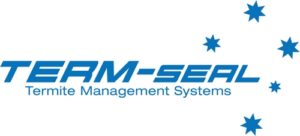
“TERM-seal Termite Management Systems provide superior protection against Termites, and moisture protection.
Bifenthrin is an active control agent which repels and kills Termites but is safe for humans, animals and the environment when installed. Our unique patented technology incorporates this control agent in the manufacturing process of our products, which results in products with all the benefits of chemical protection without any residual, environmental or dermatological impact.
Our products have been rigorously tested by independent Australian bodies, are CodeMark certified, comply with all Australian state and territory standards, are APVMA registered and have been awarded the future friendly stamp under Cert-Mark certification.”
What are the benefits of using Term-seal?
- Integration and flexibility for all construction methods
- Combined Termite / moisture protection
- One installation, no COSTLY retreatments
- Complies with standard AS3660.1.2000
- Fully compliant with standard A.S./N.Z.S.4347.6 Damp-Coursing
- CodeMark Certified & APVMA registered
- No chemical residue: safe for your employees, your client and the environment
- Australian owned, designed and manufactured
- Installed nationally by trained accredited installers
Who should use a termite barrier?
Termite barriers should be installed if:
- You are building a new home
- If you are adding an extension to your home

![]() Each property, building and location is different, a customised management solution should be designed to suit your specific needs.
Each property, building and location is different, a customised management solution should be designed to suit your specific needs.
We would love to find out more on how we may be able to help you.
Click to call or contact with us via the contact form available at our website.

Termite Inspection Sydney
Termite Inspection Sydney

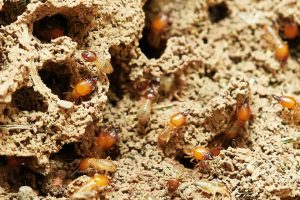 Need a termite inspection?
Need a termite inspection?

Termites cause more damage to Australian homes than fires, storms and earthquakes, as termites eat wood from the inside out, by the time it is detected termite damage can be substantial.
Annual termite inspections on your residential or commercial property by a qualified timber pest technician is highly recommended.
Even though annual inspections are not going to prevent your home from getting termites it reduces the risk of major termite damage being done to your home. Like most things early detection is the key as a developed infestation could be more expensive to treat!
By Australian standards it is recommended that termite inspections are conducted annually
Why do I need a termite inspection?
Termite inspections are the first step required to assess if a property has evidence of termites or other timber pests such as borers and if activity is found what steps need to be taken to manage the problem
Termite inspections are a vital part of all termite management programs.
As previously mentioned termite inspections should comply with the Australian Standard AS3660 recommendation that a termite inspection is completed annually.
Things do change around your property from year to year that might have encouraged a termite attack.
Termite Inspections are required on building structures however sometimes trees, retaining walls or other items can have timber pest activity. If this is the case we would also not just recommend having the infested items inspected but also the building structures inspected
Please Note: termite inspections will not eradicate existing termite activity or provide any future protection from further attack.
What areas are checked with termite inspections?
- Accessible internal and external areas of your property
- Roof cavity
- Sub floor area if accessible
- External areas extending up to 30 metres or the boundary line of your property.
- Inspection of termite-friendly areas
What equipment is used?
Termite inspections are performed using industry-best equipment including:
- Sounding equipment
- Moisture meters
- Listening devices
- Termatrac (a movement detection device based on microwave technology)
- Access to additional advanced technology like thermal imaging cameras & termite sniffer dog is also available.
Pest Control Today technicians are Termatrac certified 
The Termatrac device gives us the ability to perform non-invasive inspections including identifying high risk termite areas.
The Termatrac allows the inspector to accurately detect, confirm and track the presence of termites locate nests, mud-leads and entry points.
This enables us to provide you with a more detailed report and allows us to treat your home more cost effectively.
With the aid of the termatrac we can access areas of your home that without this technology would not be possible. These areas include inside wall cavities and sub-floors without the need to cut traps and entry points.
The 3-in-1 functionality makes the Termatrac T3i the best available tool for Pest Control Professionals.

How long does a termite inspection take?
Pest Control Todays’ termite inspection process typically takes 1-2 hours.
Termite Inspection Reports
At the completion of the inspection you will be issued with a written termite inspection report. This report is designed to give you an idea of your properties termite exposure and/or damage status.
The report will document if there was any visual evidence of a timber pest, a summary of the pests identified, if your property is at risk of a timber pest invasion.
It will also provide you with recommendations for improving the environment around your home. If activity was found where it was found, recommended treatment guide & advice on how to protect your home.

![]() Each property, building and location is different, a customised management solution should be designed to suit your specific needs.
Each property, building and location is different, a customised management solution should be designed to suit your specific needs.
We would love to find out more on how we may be able to help you.
Click to call or contact with us via the contact form available at our website.

Spider Identification Chart
Spider Identification Sydney


Termites
Termite Pest Control Sydney
![]()
Need termite control?


Termites also known as white ants are small and a similar in size to ants. Due to their size and similarities to ants this can often lead to confusion. Knowing the differences between these two pests is a good starting point for identification.
Termites are secretive in nature which makes their detection difficult to an untrained eye. Most people would be more likely to spot the signs of termite damage rather than the actual termites.
Correct identification ensures the most effective treatment methods are used and allows you the home or business owner to choose appropriate prevention steps to try and avoid termite infestations in the future.
What Do Termites Look Like?
Do termites really look like ants?
Termite Pest Control Sydney
Termite alates or swarmers can look like flying ants. There is a simple way to determine if the flying ants you are seeing are termites or flying ants, and this is simply by how many body sections there are. As seen in the image below – Termite alates have 2 body sections while standard flying ants have 3.
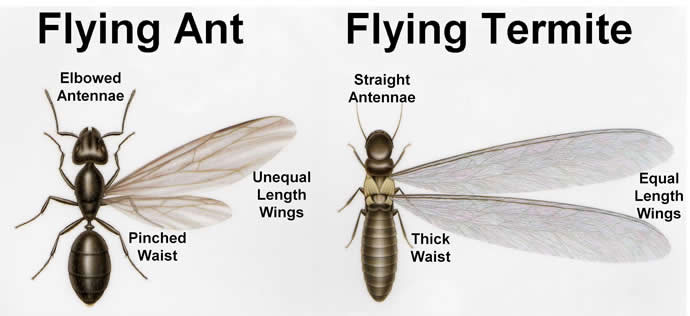
Here’s how to establish the general differences in appearance and behaviour between ants and termites:
- Termites have a straight waist, ants have a pinched waist.
- Straight antennae, ants have bent antennae.
- Their wings are the same length, ants have wings of different length.
NOTE: Flying ants do not shed their wings. If you have seen flying ants in your property and have found discarded wings,chances are you have identified termites in your property.

Termite Pest Control Sydney – How can termite damage be identified?
Rather than just looking at the areas where visible damage has been identified, Pest Control Today confirms termite infestations with a visual inspection and the use of a termatrac system.
When checking your property whether it be your residential home or business there are some points that could assist you in identifying possible termite activity.
Subterranean termites begin their feeding process from the ground up and enter a building through the sub-structure. Houses that are built on concrete slabs can still be affected if the slab has cracked and allowed an opening from the soil through the slab to the house.
Houses that have an open access sun floor or crawl space are at a great risk of termite infestations. This area should be checked for evidence of wood damage and/or mud tubes.
This species of termite damages the wood by developing hollow tunnels known as galleries which run along the wood grain.
Drywood termites usually enter the building near the roof line or in areas where wood has been exposed. Attics and roof cavities should be checked for wood that has been damaged. You may see tiny holes in the wood with collected frass nearby. Probing the wood can also expose galleries
I have found termites, what do I do?
Finding termites in your home can be distressing, however Pest Control Today recommends firstly that you stay calm and call a professional. Do not disturb any termite workings, mud trails, leads of galleries and we ask that you do not spray the area with any insecticides as it can be make treatment harder.
How are termites treated?
Not all building structures are the same Pest Control Today will offer you a program designed to suit your properties needs.
There are 2 ways to treat termites, baiting/dusting or direct chemical treatment. Sometimes a combination of both treatments will be required or recommend.
Baiting or Dusting
Termite baiting
is conducted by placing bait stations in specific areas around your home which are baited using a non-chemical bait that contains an active ingredient which the termites eat and carry back to the colony where they share it amongst other termites in the nest.
Termite Dusting
is completed using Termidor Dust which is a non-repellent which is very similar to the material used in the bait systems. Small holes are made into the infested timber or directly on termite trails. The fine dust is applied directly to the termites and the holes are then covered which prevents any dust escaping and to also reduce the risk of the termites being disturbed.
NOTE: Termite dusting & baiting does not provide protection to the building from future termite infestations.
Chemical Application
Termite Soil Treatment
Preferred option by many pest controllers however its use does depend on the construction type of your property. The treatment is applied to soil areas where the building is in contact with:
- Subfloor
- Concrete slab perimeters
- External wall perimeters.
If there is a distance greater than 400mm between the soil and the timbers in the floor, the subfloor would also be trenched and treated, however it is preferred that the entire sub floor area is treated which increases the coverage area in the subfloor which in then increases the chance of the termites encountering the chemical.
Drilling & Injection of chemical to the concrete perimeters occur approximately at 20-30cm intervals. The drilled holes are then re concreted on completion
The areas that may need to be drilled and injected can include:
- Patios
- Paths
- Garage
- Fireplaces
- Bathrooms
- Laundries
- External Perimeter Walls
What types of soil treatments are there for termites?
There are 2 main types of soil treatment available, the repellent and the non-repellent.
Repellent
This type of termiticide works by creating a barrier around the house which create a no-go zone for termites. For this treatment to be effective it needs to be applied in an unbroken method around the foundations. This method is often difficult to achieve simply because of the construction and design of your property or if there Is concrete against the house.
Non-repellent
This type of termiticide works as termites are unable to detect the area that has been treated and will not avoid the treated area. When termites pass through the chemical in the treated area they become in contact with it, return to the nest and pass it amongst the other termites in the colony.
Pest Control Today Recommendations

- Disturb any termite workings, leads, galleries.
- Spray termite infested area with any chemical.
- Plant trees or plants close to the house.
- Add mulch or any type of bark to the gardens too close to the property.
- Cover weep holes in brickwork.
- Allow soil to build up over the edge of the slabs.
- Place plastic or newspaper on gardens.
- Allow moisture or dampness to build up in the sub floor as poor sub-floor drainage will attract termites.
If you notice or worried about possible termite activity do not hesitate to seek professional assistance.
You should check the following areas on a regular basis
- Timber frames inside the home
- Fences
- Blistered paint on the walls
- Bulging or rippled walls
- Timber joints or gyp-rock walls for mud packing
- Foundation walls, piers and edges of concrete slabs for termite mud galleries
- Form-work timbers beneath suspended concrete patios
Remove any:
- Stored timber or cardboard that is contact with the ground in the sub-floor
- Timber stored alongside the house & kept as far away from the house as possible
Common misconceptions about termites
Myth: Termite damage can be easily seen
Fact: As termites eat wood from the inside out a new termite infestation would not have any visual signs that can be easily seen. By the time damage is noticed on the outside of the wood, extensive damage could have already occurred.
Myth: Termites are more active during spring and summer
Fact: Termites are active all year round.
Myth: Preventing termites is hard
Fact: Termite prevention is a matter of common sense and regular home maintenance such as
- Keeping gutters clean of debris
- Removing dead trees and their stumps
- Removing fallen branches
- Keeping timber and firewood off the ground and away from your home.
- Fixing water leaks in and around your home
- Having your home inspected annually by a timber pest expert. Click here to read more about termite inspections.
Pest Control Today highly recommends annual Termite Inspections.

![]() Each property, building and location is different, a customised management solution should be designed to suit your specific needs.
Each property, building and location is different, a customised management solution should be designed to suit your specific needs.
We would love to find out more on how we may be able to help you.
Click to call or contact with us via the contact form available at our website.

Spiders
Spider Pest Control Sydney
![]()
 Redback Spider Pest Control Sydney | Hunstman Spider Pest Control Sydney| Funnel Web Spider Pest Control Sydney | White Tail Spider Pest Control Sydney | Mouse Spider Pest Control Sydney | Brown House Spider Pest Control Sydney | Trap Door Spider Pest Control Sydney | St Andrews Cross Pest Control Sydney
Redback Spider Pest Control Sydney | Hunstman Spider Pest Control Sydney| Funnel Web Spider Pest Control Sydney | White Tail Spider Pest Control Sydney | Mouse Spider Pest Control Sydney | Brown House Spider Pest Control Sydney | Trap Door Spider Pest Control Sydney | St Andrews Cross Pest Control Sydney
Need Pest Control for spiders?

Spiders are one of the most feared and disliked creatures worldwide. Australia is home to some of the world’s deadliest spiders such as the funnel-web and red back spider.
It must be stated that not all spiders are dangerous, and some are beneficial to the environment.
Spiders can be divided into two main groups:
- Ground/crawling or Hunting spiders
- Webbing Spiders
Common Spiders Found in Sydney
The most common spiders that can be found in sydney are
- The Redback Spider
- The Huntsman Spider
- The Funnel Web Spider
- The White Tail Spider
- The Mouse Spider
- The Brown House Spider
- The Trap Door Spider
- St Andrews Cross Spider
To view the Australia Spider Identification chart – Please click here

The red back spider can be found across all parts of Australia and will live anywhere there is adequate food, a sheltered area for its web and is warm enough for breeding. The Red Back Spider is easily recognised by its black body with a prominent red hourglass shape on its abdomen.
Appearance
- The female is about 1cm in length & the male can range from 3-4mm in length
- The female is black (sometimes brown) with a distinctive red or orange marking on its back
- Markings may be broken into spots in front
- White lines may be visible
- The female can grow up to 15mm long.
- Males are very small and usually only grow up to 5mm long
- The male has more complex markings than those of the female
- White and yellow markings may also be seen on the male
Habitat
- Can be found in logs or under rocks
- They tend to reside in dark, dry areas.
- They can also be seen in roof eaves floorboards, toilets, shelves, flower pots, garages or sheds
- Their web is a triangle shape of dry silk
- Trap lines are sticky which assist in catching prey
- Red back spiders are carnivorous eating almost any small insects that are caught in their webs.
- They are known to also eat skinks and even juvenile mice, snakes and frogs
- The red back spider rarely leaves its web
Huntsman spiders are known as being the “hairy tarantulas”. They are often seen inside your home on the walls or from coming out from behind curtains.
Appearance
- Mostly brown, black and grey in colour
- The body length of the male is 1.6cm and the female has a body length of 2cm
- Their legs can span up to 15cm
- The back legs are shorter than the front legs
- Their legs span out sideways allowing them to walk both forward and sideways
Habitat
- Can be found on tree trunks, under stones, under bark, on the windows and walls inside your home.
- Can also enter cars & run across the dashboards
- Can live between hairline cracks, sandstone and granite outcrops
- Feeds on a variety of insects, small lizards and frogs
- Stalks and run down its prey
- Poisonous to humans but not fatal

The Sydney Funnel-web Spider is one of the deadliest spiders in the world. When the funnel web is threatened it raises its front legs high off the ground and point its fangs forward ready to strike. When it strikes it drives its fangs down with force and speed.
Appearance
- The cephalothorax is hairless and appears smooth and glossy black
- Black, brown or purplish abdomen
- Body and legs are covered with fine hairs
- The male has more slender legs
- The male has a spur on the 3rd part of the 2nd leg
- The male is 20mm in length & Female is 30mm in length
Habitat
- Prefer forested areas
- Private gardens
- They build silk-lined burrow under a rock or log
- The burrow can be up to 60cm long
- The burrow has 2 entrances
- The burrow entrance has thicker lines of silk radiating from the entrance to form trip-lines
- They are attracted to water
- Can be found in your swimming pool
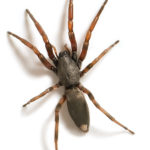
White-tailed Spiders can be found all over Australia and its bites cause severe skin ulceration in humans. White-tailed spiders hunt their prey instead of waiting to catch it in a web. Their preferred diet is other spiders
Appearance
- Medium sized spider
- Male body length is 12mm & Female body length is 20mm
- Long cigar-shaped dark grey abdomen
- The abdomen is grey and has two pairs of faint white spots
- A distinct white or cream spot can be seen at the tip of the abdomen just above the spinnerets.
- The legs are brown or reddish brown in colour.
- They are slow moving spiders
- They travel great distances looking for prey
- Mostly active at night.
Habitat
- Cool dark areas
- They often come into houses
- They are sometimes found in the folds of clothes, towels and shoes.
- They live beneath bark and rocks
- In leaf litter
- Logs
- Detritus in bush
- Gardens
- Houses
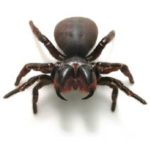
There are 11 known species of mouse spider in Australia and they are related to the trapdoor and the Sydney funnel web spider. Mouse spiders should be considered dangerous and treated with caution as they can be aggressive and will bite if provoked.
Appearance
- Dark brown or black in colour
- medium to large spiders located at the rear of the abdomen
- Their size varies between 10-35mm with the male being smaller than the female
- High, bulbous heads and jaws
- The carapace is smooth and shiny
- The eyes are spread across the front of the carapace
- The spinnerets are short, the last segment domed and button-like
- Male spiders have long slender pedipalps
- Male spiders have no mating spurs on the legs
- Males of some species have distinctive colour markings, but others are black overall
Habitat
- Can be found in both coastal and drier habitats throughout Australia
- Live in burrows in soil covered with a hinged top
- Large, silk-lined burrows can vary from 20 cm to 55 cm deep
- They create two surface trapdoors, at right angles to each other
- Difficult to see as the silk and soil trapdoors merge well with the soil
- Heavy rain often forces them out of their burrows

The brown house spider is sometimes mistaken for the red back spider as it has a similar body shape and webbing. It can often be found in dark places inside your home. External sheds, under empty plant pots or among general rubbish.
Appearance
- The female can grow up to 1.2cm and the male being slightly smaller
- Mottled cream to brown in colour
- The legs are reddish brown and are shiny and thin
- Legs can span up to 25mm
- Spider but does not inflict a dangerous bite.
- Web may include a curled leaf as a retreat for the spider.
Habitat
- Builds untidy, tangled webs
- Webs can be found on walls, under eaves, around garage doors and among leaves on trees and shrubs.
- Undisturbed dark areas are ideal for this spider
- In a cupboard signs of a brown house spider could be white specs of spider droppings

Most trapdoor spiders are misleadingly named, as not all species make a door for their burrows. Their camouflaged entrances are almost undetectable, unless the door is open. Brown Trapdoor Spiders are often mistaken for Funnel-web spiders, but their bites are not dangerous. Local pain and swelling may occur.
Appearance
- Medium to large spider
- female larger than the male
- Female size 35mm and the male is 20mm in length
- The female has a stocky build
- Short, blunt spinnerets
- There are often pale bars across the abdomen
- Dull brown to black in colour
- Males have boxing glove shaped palps at the front of the head
- Hairs cover the body and legs
Habitat
- Spends most of the time in their burrows
- They wait for food by the front of their burrows
- Burrows are lined with silk
- The burrow can be as long as 25cm and approx. 25mm in width
- Silk trip lines radiate from the burrow entrance
- Burrows are used for protection and raising young
- The burrow is made wider and longer as the spider grows

The St Andrews cross spider can be found across Australia and is named because of the silky bluish white cross pattern it creates on its web, like that of the St Andrews Cross on the flag of Scotland.
Appearance
- The Female is 10 – 16 mm in body length
- The male is 3-4mm in body length
- Females abdomen is banded silver, yellow, red and black with 2 yellow stripes below
- Sits with its legs in pairs
- The males are brown and cream coloured
- The web is a medium-sized orb
- The spiderlings are cream-coloured
Habitat
- Can be found on Low shrubby vegetation both during the day and night
- Suburban gardens
- Rainforest margins
- Males build smaller webs close to the female

![]() Each property, building and location is different, a customised management solution should be designed to suit your specific needs.
Each property, building and location is different, a customised management solution should be designed to suit your specific needs.
We would love to find out more on how we may be able to help you.
Click to call or contact with us via the contact form available at our website.

Silverfish
Silverfish Pest Control Sydney
 Need pest Control For silverfish?
Need pest Control For silverfish?

Silverfish are known for their destructive feeding habits and prefer to live in warm and moist spaces, like basements, crawl spaces and can often be found in the bathroom or laundry. They can survive in almost any environment and are nocturnal pests that move quickly.
Silverfish have been known to stain the items they hide in such as books, cupboards, stored clothing and wall paper.
What do silverfish look like?

Silverfish are white to brown-grey or a blue – silvery colour, their bodies are shaped like a teardrop and range from 12-19 mm in length. They have 3 long bristles on their rear end.
Where do silverfish live?
Silverfish are capable of surviving in all climates, however they do prefer to live in dark & damp areas such as basements, kitchens, bathrooms & attic spaces. They are attracted to paper goods and damp clothing. Silverfish can be found in stored boxes that are kept in sheds or garages.
What do silverfish eat?
As silverfish like to dine on anything and everything they have been known to feed on paper, clothing and even wall paper. They feed on carbohydrates, sugars and starch. It is suspected that silverfish will also feed on shampoo, glue in books, linen & dead insects. Silverfish have also been found in unopened food packages.
How did I get Silverfish?
Silverfish are usually introduced to the home by carrying them in either by cardboard boxes or plastic containers which had been stored in infested areas.
They usually enter homes through cracks in the foundation, torn fly or door screens, gaps around doors. Leaving dirty dishes out in the open will also attract silverfish indoors.
What issues can silverfish cause?
Silverfish have been linked to:
- Allergies
- Attract other pests
- Damage to personal items

![]() Each property, building and location is different, a customised management solution should be designed to suit your specific needs.
Each property, building and location is different, a customised management solution should be designed to suit your specific needs.
We would love to find out more on how we may be able to help you.
Click to call or contact with us via the contact form available at our website.

Contact us
Pest Control Today
Contact Us
If you have any question, feedback or require any further information, please fill out the form below and we will be in touch within 24 hours.



